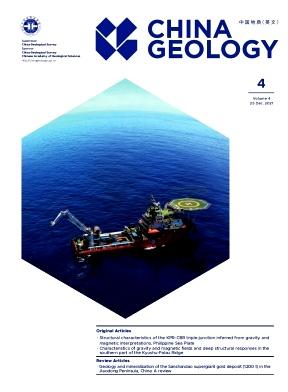洞庭湖水体和沉积物中新烟碱类杀虫剂的发生、迁移及生态风险评价
IF 4.7
3区 地球科学
Q1 GEOSCIENCES, MULTIDISCIPLINARY
引用次数: 0
摘要
新烟碱类杀虫剂因其高效、低毒的特点,已成为全球杀虫剂市场的重要组成部分。然而,它们的环境持久性引起了重大的生态问题。洞庭湖是中国重要的淡水湖,其生态系统健康与否直接关系到区域生态平衡和人民生计。本研究系统调查了洞庭湖流域水体和沉积物中近地天体的赋存特征及生态风险。本研究基于26个代表性采样点的地表水和沉积物样品,采用液相色谱三重四极杆质谱法对9个近地天体进行了定量分析。利用风险商(RQ)法和逸度模型对neo的生态风险进行了评价。结果表明,水体中存在6种neo:吡虫啉(IMI)、啶虫啉(ACE)、噻虫胺(CLO)、噻虫嗪(THIA)、氟虫胺(FLO)和呋虫胺(DIN)。6种neo的总浓度平均值为275.11 ng/L。在沉积物中鉴定出5种优势neo(即IMI、THIA、ACE、CLO和DIN),平均浓度为0.31 ng/g。洞庭湖流域水体中NEO浓度依次为香江、紫水、沅江、丽水(统称“四江”)、洞庭湖干流、新强河、汨罗江、虎都河、大内河、松子河(统称“三口”)。支流的沉积物逐渐积聚在湖中。生态风险评估确定IMI和DIN为风险最高的化合物(RQ >;1)高发区集中在洞庭湖干流和大内河、汨罗河、虎渡河。逸度模型表明,IMI、ACE和THIA在大部分地区容易从沉积物向水体扩散,逸度分数(ff)值大于0.5。相反,洞庭湖干流作为CLO和DIN (ff值:<;0.5)。湖出口处的沉积物是近地天体的重要汇。根据研究结果,建议加强对农业地区近地生物应用的监管,并实施分区控制策略。这些措施将有助于降低生态风险,保护洞庭湖区水生态系统的安全。本文章由计算机程序翻译,如有差异,请以英文原文为准。
Occurrence, migration, and ecological risk assessment of Neonicotinoid insecticides in water and sediments of Dongting Lake, China
Neonicotinoid insecticides (NEOs) have become an integral part of the global insecticide market due to their high efficiency and low toxicity. However, their environmental persistence has raised significant ecological concerns. Dongting Lake represents a vital freshwater lake in China, and its ecosystem health directly affects regional ecological balance and people’s livelihoods. This study systematically investigated the occurrence characteristics and ecological risks of NEOs in water bodies and sediments across the Dongting Lake basin. Based on surface water and sediment samples collected from 26 representative sampling sites, this study quantified nine NEOs using liquid chromatography triple quadrupole mass spectrometry. Furthermore, it assessed ecological risks posed by the NEOs using the risk quotient (RQ) method and fugacity modeling. The results revealed the presence of six NEOs in the water bodies: imidacloprid (IMI), acetamiprid (ACE), clothianidin (CLO), thiamethoxam (THIA), flonicamid (FLO), and dinotefuran (DIN). The total concentrations of these six NEOs averaged 275.11 ng/L. Five predominant NEOs (i.e., IMI, THIA, ACE, CLO, and DIN) were identified in the sediments, with a mean concentration of 0.31 ng/g. The NEO concentrations in the water bodies across the Dongting Lake basin increased in the order of the Xiangjiang, Zishui, Yuanjiang, and Lishui rivers (collectively referred to as the Four Rivers), the mainstream of Dongting Lake, the Xinqiang River, the Miluo River, and the Hudu, Ouchi, and Songzi rivers (collectively referred to as the Three Outlets). Sediments from tributaries progressively accumulate in the lake. The ecological risk assessment identified IMI and DIN as the highest-risk compounds (RQ > 1), with high-risk areas concentrated in the mainstream of Dongting Lake and the Ouchi, Miluo, and Hudu rivers. The fugacity model showed that IMI, ACE, and THIA are prone to diffuse from sediments to water bodies in most areas, with fugacity fractions (ff) values of greater than 0.5. In contrast, the mainstream of Dongting Lake acts as a sink of CLO and DIN (ff values: < 0.5). Sediments at the lake’s outlet emerge as an important sink of NEOs. Based on the results of this study, it is advisable to strengthen the supervision of NEO applications in agricultural areas and to implement zonal control strategies. These measures will help reduce ecological risks and protect the safety of water ecosystems in the Dongting Lake region.
求助全文
通过发布文献求助,成功后即可免费获取论文全文。
去求助

 求助内容:
求助内容: 应助结果提醒方式:
应助结果提醒方式:


